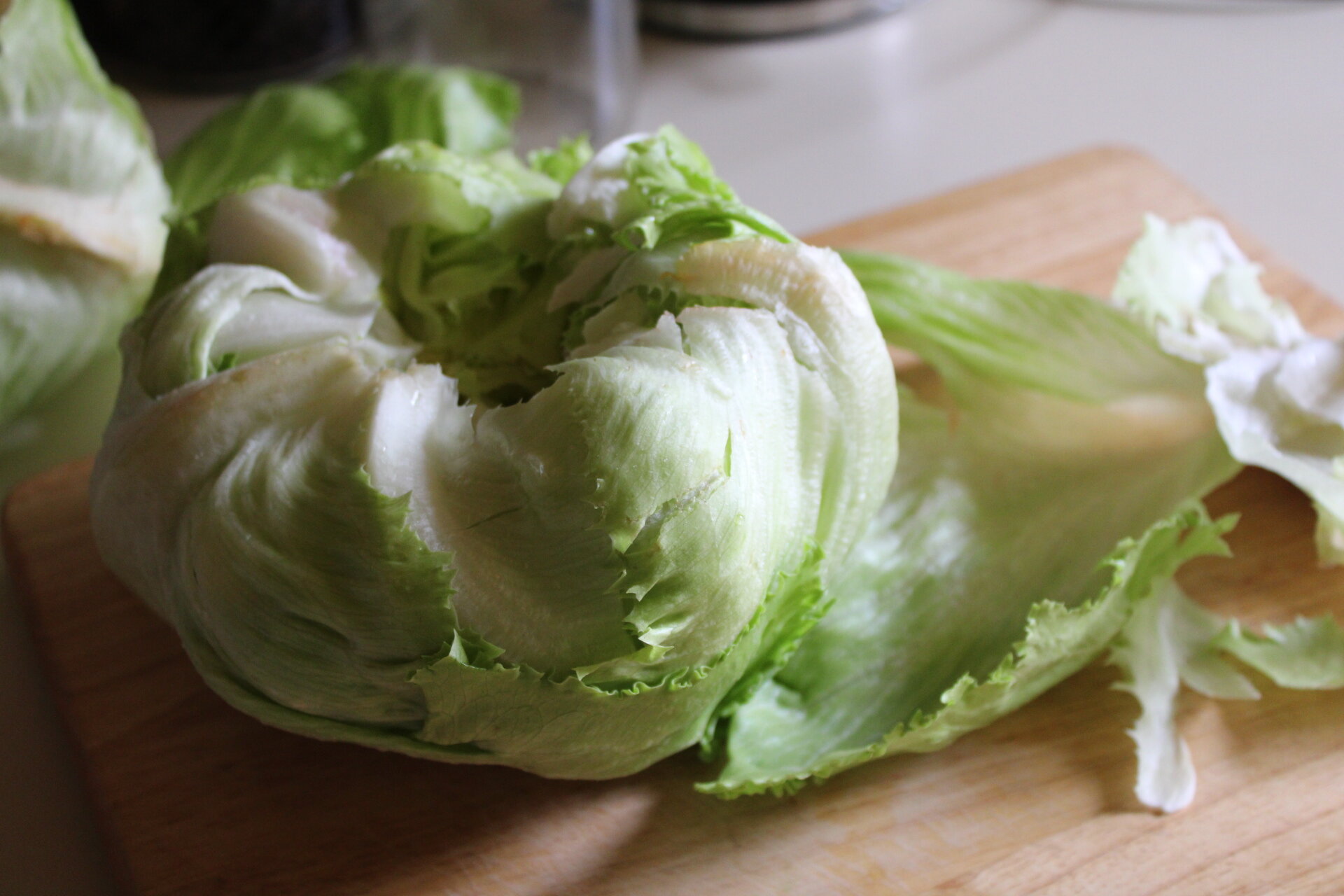Iceberg Lettuce

Lactuca Sativa
Iceberg lettuce is in the same family of plants as sunflowers, artichokes, dahlias, chamomile and a flurry of other flowers and fruits that most people are familiar with. The Asteraceae or Daisy family. However, these days iceberg doesn’t get as much love as its plant siblings.
It tends to be at the bottom of the totem pole for “foodies”, often due to aesthetic and nutritional reasons, but iceberg has also lost favor with food activists who’ve considered its implications and history in the food system. Like most plants though, outside of our capitalist society iceberg has an identity all its own.
Lettuce (Lactuca sativa) with plant siblings - Illustration by Mark Stansberry II for Seeds & Receipts
By looking at the botany and etymology of lettuce, we can see that its name gives us a clue about some of its functions. “Lettuce” comes from the scientific species name Lactuca sativa (L. sativa) due to the milky nature of its stems. If you’ve ever harvested a head of lettuce, or broken its stubby stalk, you’ve seen how this milk releases itself freely from those thick, veiny petioles.
This milk from the stems, as well as the oil from the seeds, had been used for millennia as an aid for sleeping by people in ancient Greece, Egypt (where it was first cultivated over 4000 years ago), and Sumer (in what today would be southern Iraq). The oil of lettuce could also be used to improve the health of skin and hair. On top of helping folks get rest and have glowing skin, ancient people used lettuce for the same reason my mom did, to help with the digestion of other foods, or just to add some crunch and juiciness to an otherwise carb and protein heavy meal.
Depiction of Sumerian kid getting some of that lettuce milk from their mom to help with sleep. - Illustration by Mark Stansberry II for Seeds & Receipts
Crunch and juice is what led to iceberg lettuce’s original common name “crisphead” when iceberg was developed by the Burpee Seed Co. in 1894. Crisphead/Iceberg is a group of lettuce in the L. sativa species that forms a head and has layers of juicy, crisp leaves. Hence the name. There have always been head lettuces, but Burpee developed iceberg in particular for it to look a certain way and store better than most types.
Some sources say that iceberg was known as crisphead up until the 1940’s, at which point it began being transported on trains for long distances and required ice to preserve its crispiness. While other sources say it was always called iceberg for its signature cold, crisp taste. Although there are tons of flavorful, even colorful crisphead varieties available for purchase from seed companies, most people will only recognize the pale green varieties like Gondar and Crispino.
Iceberg’s name isn’t the most significant part of its history though. After all, if other more nutritious and flavorful varieties of iceberg, and lettuce in general, have existed just as long as the paler, greener versions, why would those varieties not be as familiar to most people?
Iceberg hanging out in my kitchen.
One of the reasons for this, similar to chicken and corn, is that iceberg lettuce fell subject to the time period between the 1930-70s in which the U.S. food system was rapidly pivoting away from small scale farms and communities to mass production and industrialization.
The “get big or get out,” proclamation by racist USDA director Earl Butz in the early 70s personified this shift.
Google screenshot of Readers Eagle article about agriculture in 1973
With mass production and industrialization came a not-so-new form of labor and land exploitation, and with that the dilution of plant diversity and mono-crop farms. In the 1930s when the first large scale farms had established themselves in Central California, they used the labor of migrant farm workers from The Philippines, and farmers were encouraged to grow fields of mono-crops like green iceberg lettuce.
Filipino farmers in Salinas and Watsonville would not only be subject to low pay to work these fields, but would also experience violence and murder from White nativists as well as Irish and Italian immigrants who felt farm worker jobs were being degraded and stolen. The demand for iceberg lettuce would exacerbate these conflicts.
Still, iceberg production would increase over the next few decades and the farm working pool would begin to include Mexican immigrants. During the 1970s Mexican farm workers in Central California started pushing the public to boycott non-union lettuce growers during the Salad Bowl Strikes. These strikes would be led by United Farm Workers founders Dolores Huerta and César Chávez along with thousands of other farm workers. Their efforts would eventually cause the California Agricultural Labor Relation Act of 1975 to get passed.
While the passage of the act ensured that farmworkers would be allowed to organize against poor working conditions, it wouldn’t automatically eliminate those poor working conditions. Therefore, today the fight continues for farm working conditions to be humane at the very least.
Farmerworkers picketing in 1970 Photo: Wayne State University
Rather than this history causing large swathes of Americans and corporations to demand farm workers be paid high-wages and have humane work environments, iceberg has slowly fallen out of favor with “foodies” and chefs over the past 40 or so years. With the help of figureheads like Alice Waters, and other White food saviors, iceberg’s been transformed into a symbol of the uneducated palate and poor quality food.
The formation of this ideology has made way for romaine lettuce and mixed baby greens. The types of salad greens that are often praised for being nutrient dense, flavorful, and “organic”. Iceberg’s medicinal properties have thus been long forgotten due to a foodie culture that is drawn to greens that give the illusion of something more nutritious and virtuous. Greens seemingly untouched by the politics of poor working conditions for farm workers.
From a Market Watch article on Iceberg Lettuce Consumption Trends in U.S. (2016, article here)
However, whether it’s romaine or iceberg, any fruit or vegetable that is grown on a large scale or as a mono-crop still comes at a hidden cost in the form of exploited farmworkers and reduced biodiversity on farms. Therefore, while I won’t be purchasing iceberg anytime soon, it’s not because I think it’s a lesser green, or because I think skipping it means I’ve reduced my impact on the environment, or that I’ve done my part to support farmworkers.
Instead I’ll continue to unearth and embrace iceberg lettuce’s true history, and perhaps at some point try my hand at cultivating the other varieties of it to see what stories this plant has to share with me. After all there’s really no point in hating on plants that had no way to opt out of our current food system’s exploitative and White supremacist nature.
Broken lettuce.
Bibliography (aka Read More . . .)
Fischer, N. (2018). The History of Lettuce - Plant Profiles - Heirloom Gardner. Retrieved July 26, 2020, from https://www.motherearthgardener.com/plant-profiles/edible/the-history-of-lettuce-zm0z18szphe
Greenaway, T. (2013, March 26). Tip of the Iceberg: Our Love-Hate Relationship With the Nation's Blandest Vegetable. Retrieved July 26, 2020, from https://www.smithsonianmag.com/arts-culture/tip-of-the-iceberg-our-love-hate-relationship-with-the-nations-blandest-vegetable-9074175/
Levy, L. L. (2018). Chapter 6: Riotous environments Filipino immigrants in the fields of California. In M. Armiero & R. P. Tucker (Authors), Environmental history of modern migrations (pp. 111-121). London, OX: Routledge.
McGee, H., Dorfman, P., Greene, J., & McGee, A. (2004). Chapter 6: A Survey of Common Vegetables. In On food and cooking: The science and lore of the kitchen (pp. 318-321). New York: Scribner.
No Author Attributed. (1970, August 25). Farm Union Halts 'Salad Bowl' Work. Retrieved July 26, 2020, from https://www.nytimes.com/1970/08/25/archives/farm-union-halts-salad-bowl-work.html
No Author Attributed. (1970, November 13). Farm Workers Press Lettuce Boycott: News: The Harvard Crimson. Retrieved July 26, 2020, from https://www.thecrimson.com/article/1970/11/13/farm-workers-press-lettuce-boycott-ppicketing/
No Author Attributed. (2018, March 31). From the Archives: The Lettuce Strike of 1973. Retrieved July 26, 2020, from https://www.colorado.edu/libraries/2018/03/31/archives-lettuce-strike-1973
No Author Attributed. (n.d.). The History of Iceberg Lettuce. Retrieved July 26, 2020, from https://kitchenproject.com/history/Salads_Lettuce/IceburgLettuce.htm
Pawel, M. (2015, July 28). Cesar Chavez Gave Salinas a Sense of Its Own Power: Essay. Retrieved July 26, 2020, from https://www.zocalopublicsquare.org/2015/07/28/cesar-chavez-gave-salinas-a-sense-of-its-own-power/ideas/nexus/
Sears, S. (2018, July 31). Today in Labor History - August 24th. Retrieved July 26, 2020, from https://voicesoflabor.com/2018/08/24/today-in-labor-history-august-24th-4/
Yakoot, M., Helmy, S., & Fawal, K. (2011). Pilot study of the efficacy and safety of lettuce seed oil in patients with sleep disorders. International journal of general medicine, 4, 451–456. https://doi.org/10.2147/IJGM.S21529






